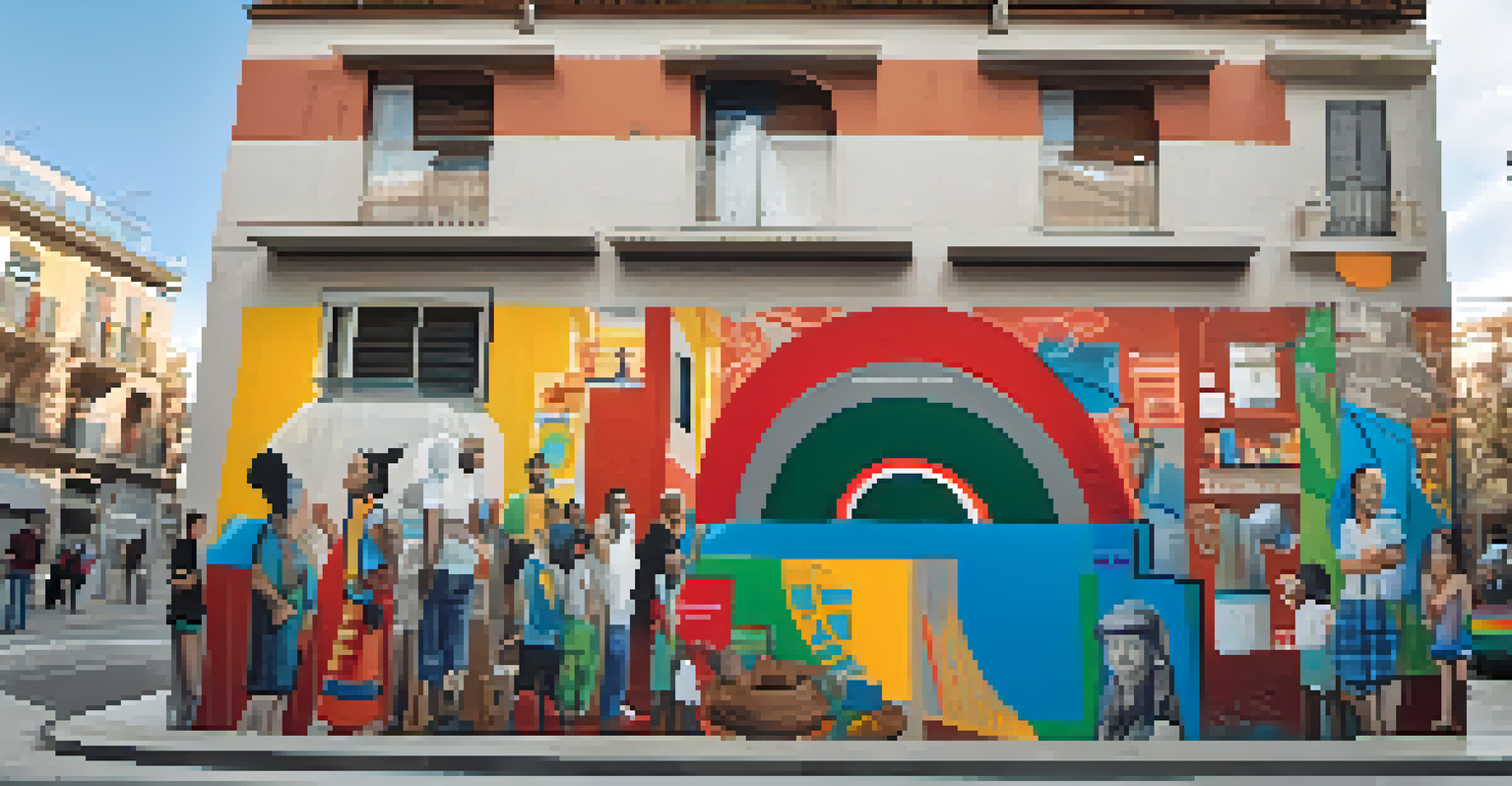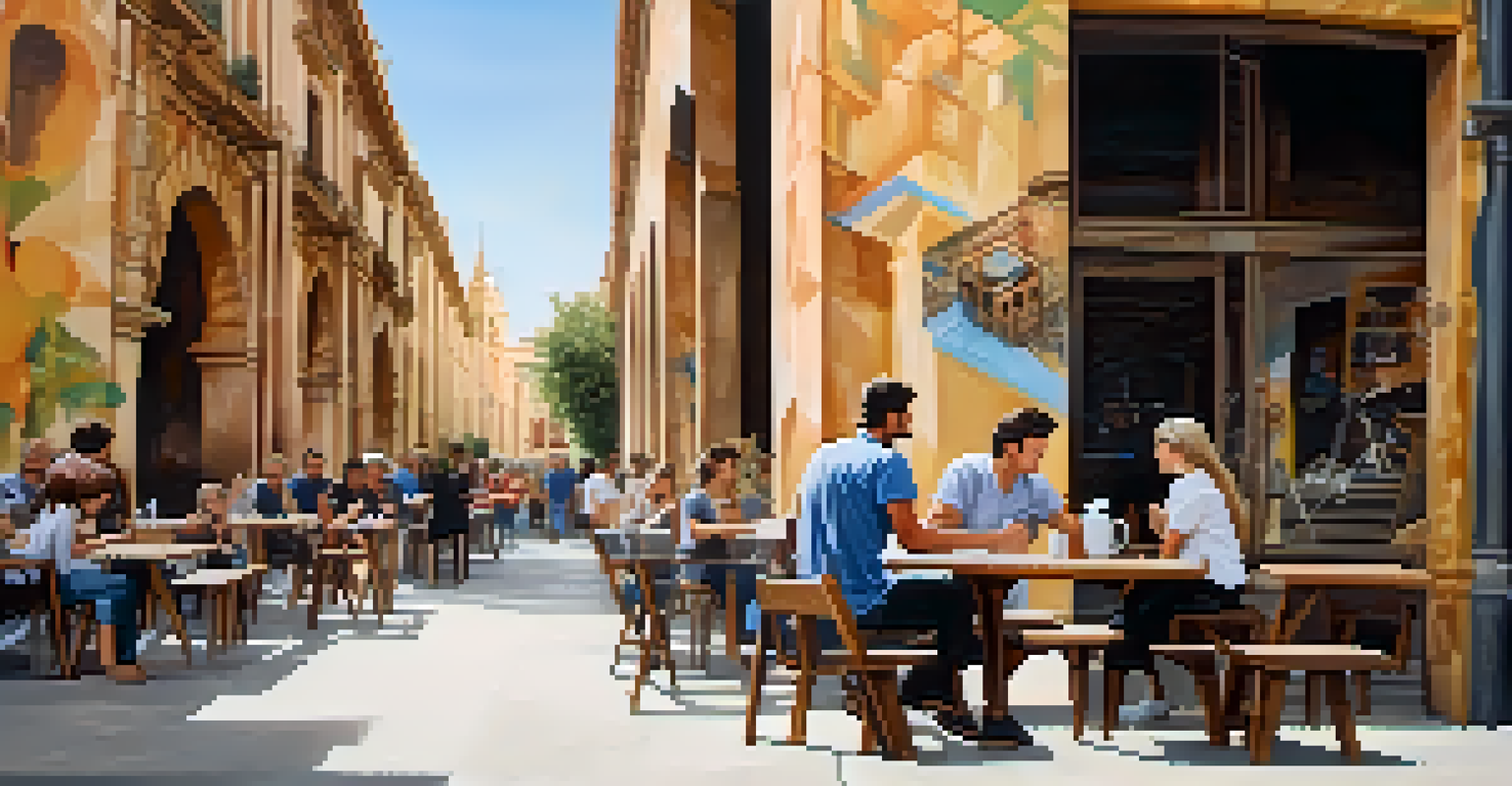The Role of Street Art in Urban Regeneration in Spain

Understanding Urban Regeneration and Its Importance
Urban regeneration refers to the process of revitalizing deteriorating areas, often to enhance their economic and social viability. In Spain, many cities have faced challenges like economic downturns and population decline, making regeneration crucial. This process encompasses various strategies, including infrastructure improvements and community engagement, to breathe new life into neglected neighborhoods.
Art is not what you see, but what you make others see.
One of the most compelling aspects of urban regeneration is how it can transform not just buildings, but also the lives of the people who inhabit these spaces. When done thoughtfully, it can foster a sense of belonging and pride among residents. This is where street art steps in, acting as a catalyst for change by bringing art and culture back into urban landscapes.
As we dive deeper into the role of street art in urban regeneration, we see that it’s more than just aesthetics. It’s about creating a dialogue between artists, communities, and the spaces they inhabit, ultimately leading to revitalized neighborhoods filled with creativity and life.
The Rise of Street Art in Spanish Cities
In recent years, street art has exploded in popularity across Spain, particularly in cities like Barcelona and Madrid. These urban canvases have become a means for artists to express social and political messages, often reflecting the pulse of contemporary society. As cities grapple with their identity, street art provides a unique voice that resonates with both locals and tourists alike.

Street art festivals, such as the annual 'Pinta Malasaña' in Madrid, have played a significant role in promoting this art form. They invite artists from around the world to create murals and installations, transforming entire neighborhoods in the process. This not only beautifies the area but also draws visitors, boosting local economies.
Urban Regeneration Enhances Communities
Urban regeneration revitalizes neglected areas, fostering economic growth and community pride.
Moreover, street art has become a medium for community storytelling. Artists often collaborate with residents to create works that celebrate local culture and history, fostering a sense of ownership and pride. As a result, these artworks become landmarks in their own right, cherished by the community.
Street Art as a Tool for Community Engagement
One of the most powerful aspects of street art is its ability to engage communities in meaningful ways. Through collaborative projects, residents can work alongside artists, ensuring their stories and experiences are represented. This participatory approach not only strengthens community ties but also empowers individuals to take an active role in shaping their environment.
Creativity takes courage.
For instance, in neighborhoods like El Raval in Barcelona, community-driven street art initiatives have helped to address local issues, such as gentrification and social injustice. By using art as a form of protest or awareness, residents can voice their concerns while beautifying their surroundings. This dynamic process encourages dialogue and understanding among diverse groups.
Ultimately, street art can transform public spaces into vibrant forums for conversation, creativity, and connection. As communities come together to celebrate their unique identities, they also foster resilience and solidarity in the face of urban challenges.
Economic Benefits of Street Art in Urban Areas
Street art doesn’t just beautify neighborhoods; it can also drive economic growth. When cities embrace street art, they often witness an increase in tourism and local business activity. Visitors flock to neighborhoods known for their vibrant murals, creating a ripple effect that benefits shops, cafés, and other establishments.
Moreover, many cities have recognized the potential of street art to enhance property values. Areas once considered neglected can become highly sought after as they gain recognition as cultural hubs. This transformation can lead to investment in infrastructure and services, further revitalizing the community.
Street Art Drives Economic Growth
Vibrant street art attracts tourism and boosts local businesses, transforming neighborhoods into cultural hubs.
However, it’s essential to balance economic development with community needs. While street art can attract investment, it’s crucial to ensure that long-time residents are not displaced in the process. Thoughtful planning and collaboration are key to creating sustainable economic benefits that uplift everyone.
Challenges Faced by Street Artists and Communities
Despite the positive impact of street art, artists often face significant challenges. Legal issues can arise, as many municipalities still view graffiti as vandalism rather than a legitimate form of expression. This stigma can discourage artists from creating, limiting the diversity of voices in the urban landscape.
Additionally, the commercialization of street art poses a dilemma. As neighborhoods become trendy due to their artistic appeal, there’s a risk that the original community spirit may be lost. Gentrification can push out local residents and artists, undermining the very essence of what street art seeks to celebrate.
Navigating these challenges requires collaboration among city officials, artists, and community members. By fostering an environment that values artistic expression while addressing concerns about displacement, cities can create a thriving ecosystem where street art can flourish.
Successful Street Art Projects in Spain
Several groundbreaking street art projects in Spain highlight the positive impact of this art form on urban regeneration. One notable example is the 'Muralismo' project in Valencia, where artists have transformed blank walls into stunning murals that tell the city’s story. These artworks not only beautify the area but also engage residents in discussions about their identity and heritage.
Similarly, the 'La Tabacalera' project in Madrid has turned an abandoned tobacco factory into a vibrant cultural center. Local and international artists have contributed to its walls, creating a dynamic space for exhibitions, workshops, and community events. This project exemplifies how street art can revitalize neglected spaces, bringing life and culture back to the community.
Collaboration is Key for Success
Effective urban regeneration relies on collaboration among artists, communities, and policymakers to ensure inclusivity.
These successful initiatives demonstrate that when cities embrace street art, they can create inclusive spaces that celebrate creativity and diversity. By prioritizing artistic expression, urban regeneration can become a collaborative journey that benefits everyone involved.
The Future of Street Art and Urban Regeneration in Spain
As we look to the future, the role of street art in urban regeneration in Spain seems poised for growth. With increasing recognition of its cultural significance, cities are beginning to implement policies that support and promote public art. This shift can lead to more opportunities for artists to engage with communities and contribute to revitalization efforts.
Moreover, the rise of digital technology and social media provides new platforms for artists to share their work and connect with broader audiences. This connectivity can enhance the visibility of local art scenes while encouraging collaboration across borders. As artists gain recognition, their work can inspire others, fostering a vibrant creative ecosystem.

Ultimately, the future of street art in Spain hinges on continued dialogue among artists, communities, and policymakers. By working together, they can ensure that urban regeneration efforts remain inclusive and reflective of the diverse voices that make up each neighborhood.